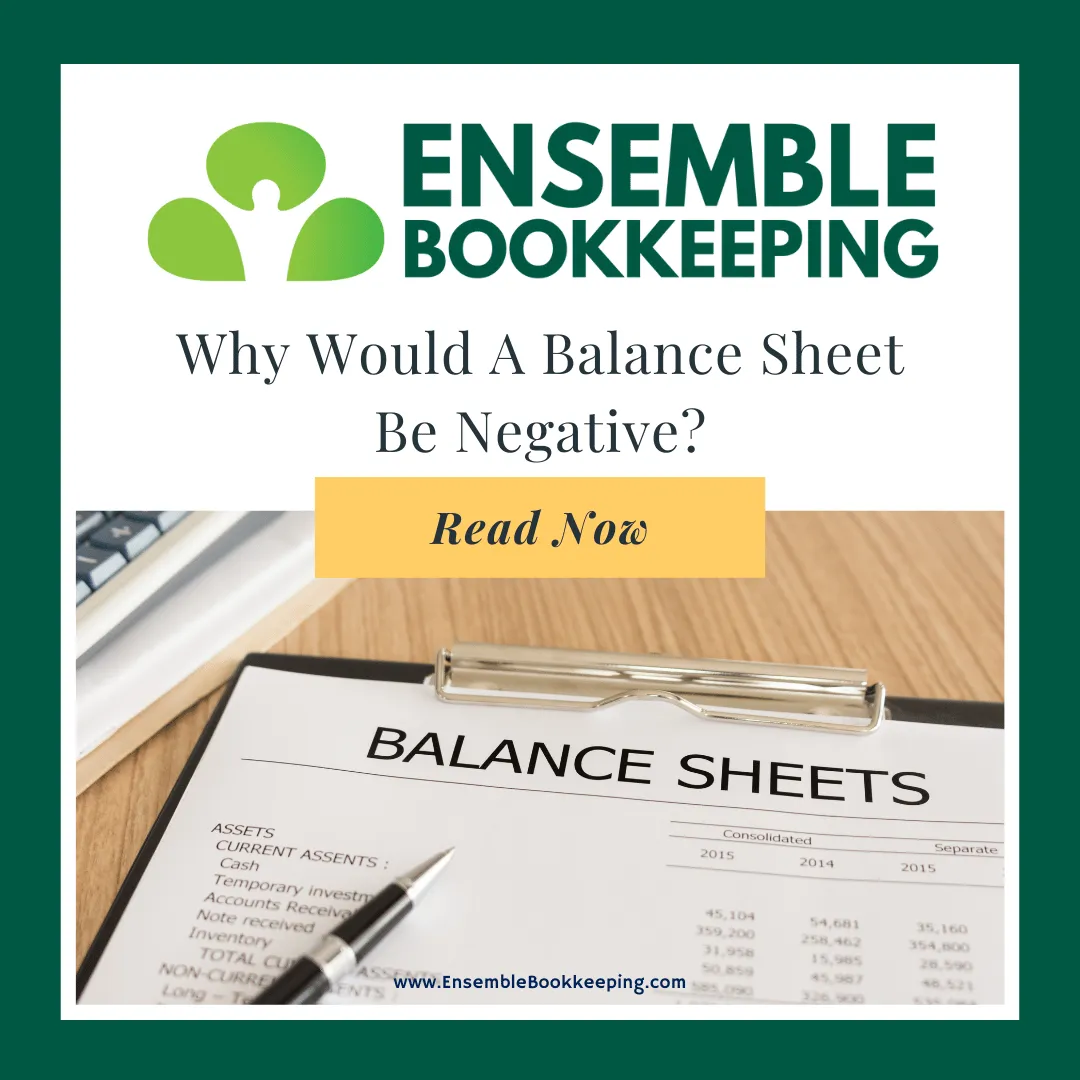The Ensemble Bookkeeping Blog

Why Would A Balance Sheet Be Negative?
If your Balance Sheet has some negative figures on it that could be a warning sign that your business is in trouble, or it could be completely normal depending on which section it hits on the Balance Sheet, the type of business you are running, and where you are in the life cycle of your business. There are several reasons why you may have a negative balance on your company’s Balance Sheet.
An obvious reason why a Balance Sheet might be negative is that the business has spent more money than it has at that point in time. This could show up as a negative balance in Current Assets when you have overdrawn your bank account.
A negative balance on the Balance Sheet for Accounts Receivable (A/R) or Other Current Assets like Inventory Asset or Undeposited Funds most likely means that some mistakes have been made in the company’s bookkeeping and some payments may have been misapplied to outstanding invoices. This could also indicate that a payment is due from the business to a customer (possibly for a refund of some sort.)
In the Fixed Assets portion of the Balance Sheet, an expected negative figure most likely would be Depreciation.
Under Liabilities, an overpayment on Accounts Payable (A/P) or Credit Card or Loan payment would show as a negative balance. Similarly, if a refund or credit was applied to say a Credit Card account that had been previously paid off this would show as a negative figure in this section of the Balance Sheet.
On the Equity portion of the Balance Sheet, negative amounts might show up under Opening Balance Equity due to accounting records starting sometime after a bank account or loan has initially started resulting in an opening balance entry. Retained Earnings can be negative if the business has accumulated a deficit in previous reporting periods. Net Income is a figure that ties to the Profit & Loss report (also known as an Income Statement). Depending on the profitability of the company in the period you are examining this figure could be negative. Total Equity could be negative depending on the balances of Opening Balance Equity, Retained Earnings, and Net Income.
If you have found a negative figure on your company’s balance sheet please continue reading and find the header below that will help to explain why that item might be negative and what that might mean for your business.
Is It OK If A Balance Sheet Is In The Negative?
A balance sheet is a financial statement that provides a snapshot of a company’s financial position at a specific point in time, showing the company’s assets, liabilities, and equity. The basic accounting principle states that the total of all assets should equal the total of all liabilities and equity, meaning that the balance sheet should balance, or have a zero balance.
Where on a Balance Sheet are Negative Numbers OK?
A balance sheet is a financial statement that provides a snapshot of a company’s financial position at a specific point in time, showing the company’s assets, liabilities, and equity. The basic accounting principle states that the total of all assets should equal the total of all liabilities and equity, meaning that the balance sheet should balance, or have a zero balance.
However, in some cases, a contra account can result in a negative balance on the balance sheet. Contra accounts are used to offset the normal balances of related accounts, and they can provide additional information that can be useful in understanding a company’s financial position. For example, a contra account called “Accumulated Depreciation” can be used to show the reduction of an asset account called “Property, Plant, and Equipment.”
In general, negative numbers are acceptable on a balance sheet when they are related to a contra account and accurately reflect the financial position of the company.
Where on a Balance Sheet are Negative Numbers a Cause for Concern?
A negative balance on a balance sheet, outside of a contra account, can indicate a state of insolvency, where the liabilities exceed the assets. This is not a healthy financial position for a company and should be a cause for concern. Negative balances in the asset, liability, and equity sections of a balance sheet can also indicate incorrect or fraudulent reporting and should be thoroughly investigated.
It’s important to note that the placement of negative numbers on a balance sheet will depend on the specific accounting principle being used, and it’s essential to ensure that the balance sheet is in accordance with the relevant accounting standards and regulations. Negative numbers on a balance sheet can provide valuable information about a company’s financial position, but it’s important to understand their context and evaluate their impact on the overall financial position of the company.
What Do Negative Numbers Mean On A Balance Sheet?
A balance sheet is a financial statement that provides a snapshot of a company’s financial position at a specific point in time, showing the company’s assets, liabilities, and equity. Negative numbers on a balance sheet can indicate a state of insolvency, where the liabilities exceed the assets. This is not a healthy financial position for a company and should be a cause for concern. Negative numbers can also indicate incorrect or fraudulent reporting and should be thoroughly investigated.
However, in some cases, negative numbers can provide valuable information about a company’s financial position when they are related to a contra account. Contra accounts are used to offset the normal balances of related accounts, and they can provide additional information that can be useful in understanding a company’s financial position.
ASSETS: Current Assets
Negative numbers in the current assets section of a balance sheet can indicate an incorrect or fraudulent reporting of the company’s assets. This section should show the assets that are expected to be converted into cash or used in the normal course of business within one year.
ASSETS: Accounts Receivable (A/R)
Negative numbers in the accounts receivable section of a balance sheet can indicate that the company has overstated the amount of money owed to it by customers. It can also indicate a problem with the company’s credit management policies or a decrease in customer demand.
ASSETS: Other Current Assets
Negative numbers in the other current assets section of a balance sheet can indicate an incorrect or fraudulent reporting of the company’s assets, or a decrease in the value of these assets. This section includes assets that are expected to be converted into cash or used in the normal course of business within one year, but are not included in the accounts receivable or cash and cash equivalents sections.
ASSETS: Fixed Assets
Negative numbers in the fixed assets section of a balance sheet can indicate an incorrect or fraudulent reporting of the company’s assets, or a decrease in the value of these assets. This section includes assets that are expected to be used in the business for more than one year, such as property, plant, and equipment.
LIABILITIES: Current Liabilities
Negative numbers in the current liabilities section of a balance sheet can indicate an incorrect or fraudulent reporting of the company’s liabilities. This section should show the liabilities that are expected to be paid or settled within one year.
LIABILITIES: Long-Term Liabilities
Negative numbers in the long-term liabilities section of a balance sheet can indicate an incorrect or fraudulent reporting of the company’s liabilities, or a decrease in the value of these liabilities. This section includes liabilities that are expected to be paid or settled after one year.
EQUITY: Opening Balance Equity
Negative numbers in the opening balance equity section of a balance sheet can indicate an incorrect or fraudulent reporting of the company’s equity, or a decrease in the value of the equity. This section shows the equity of the company at the beginning of a reporting period.
EQUITY: Retained Earnings
Negative numbers in the retained earnings section of a balance sheet can indicate an incorrect or fraudulent reporting of the company’s equity, or a decrease in the value of the equity. This section shows the accumulated earnings that have been reinvested in the business, less any distributions to shareholders.
EQUITY: Net Income
Negative numbers in the net income section of a balance sheet can indicate an operating loss for the company during the reporting period. This section shows the difference between the company’s revenue and expenses during the reporting period.
EQUITY: Total Equity
Negative numbers in the total equity section of a balance sheet can indicate a financial position where the liabilities exceed the assets, commonly referred to as insolvency. This is not a healthy financial situation for a company and should be addressed promptly to prevent further financial issues. A negative total equity balance may also indicate incorrect or fraudulent reporting, which should be thoroughly investigated.



